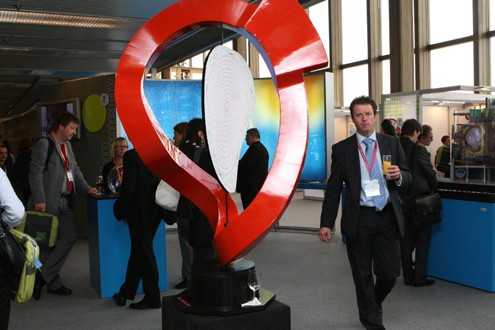
Weird stuff: a model of the Wendelstein 7-X outer magnet
By Matin Durrani
It’s amazing who you can meet at a conference.
At a sumptuous four-course dinner at Prague’s Kaiserstenjsky Palac last night – held as part of Europe’s Research Connection conference — I sat next to an Italian architect called Pietro Laureano, who researches the ancient tradition of digging tunnels in the Saraha desert.
Sounds a bit mad, but as he explained to me through mouthfuls of “saffron risotto with smoked salmon and red parmesan pancakes”, the water condenses underground, creating pools from which you can drink or use to irrigate crops. He’s funded by UNESCO and has written a book all about it.
On my right was another Italian architect and anthropologist, who has written, among other things, a book on the history of pasta. He reckons that pasta was never a tradiational Italian dish but has only became so after being eaten by Italians who left for new lives in other countries. Pasta came to embody what it meant to be Italian, apparently.
Anyway, back to physics.
Out in the exhibition at the conference, I caught up with physicists from a couple of projects we’ve been following on Physics World over the last few years. One is ASPERA – a European group seeking to improve the continent’s work in astroparticle physics.
As Thomas Berghöfer from the DESY lab in Hamburg explained, they’ve been funded through cash from the European Commission to form what is known in the jargon as a European Research Area Network (ERA-NET). With seven big new facilities on the drawing board, it’s a concrete example of what the European Research Area is all about – enhancing Europe’s strengths in science through co-ordinated action.
Meanwhile, Patrizio Antici was on hand to talk about Europe’s plans for a European Light Infrastructure – a planned exawatt laser that would be a thousand times more powerful than Megajoule in France or the National Ignition Facility in the US. (Memo to Physics World’s news editor: this is something we need to keep readers updated on.)
I also bumped into Chris Ibbott, a mechanical engineer who, working closely with physicists, helped to design one part of the ITER fusion reactor that’s currently being built in France. In front of a scale-model of the experiment, he explained just how complex this facility will be, not least trying to keep the plasma stable.
That’s why the Wendelstein 7-X reactor in Greifswald, Germany, is interesting: it can keep a plasma stable without needing a central solenoid. The snag is it’s got an outer magnet bent into a really weird shape, as the model in the photo above shows.
Like digging water-gathering tunnels in the Sahara or trying to get 27 separate European nations to collaborate, the Wendelstein 7-X reactor seems weird, but it might just work.



